UWB Low-Profile Boat-Radiator Antenna (BRA) with Dual C-Shape Co-Radiative Ground for Multi-Standard Communication Networks
Abstract
:1. Introduction
2. Configuration and Principle of Proposed BRA
3. Performance of Proposed BRA
4. Conclusions
Author Contributions
Funding
Conflicts of Interest
References
- Niehenke, E.C. Wireless Communications: Present and Future: Introduction to Focused Issue Articles. IEEE Microw. Mag. 2014, 15, 26–35. [Google Scholar] [CrossRef]
- Zhang, C.; Xie, Y. The Closed-form Solution of Frequency Shift for an HF RFID Coil Antenna in Metallic Environments. IEEE Internet Things J. 2018, 5, 3927–3941. [Google Scholar] [CrossRef]
- Panwar, N.; Sharma, S.; Singh, A.K. A Survey on 5G: The Next Generation of Mobile Communication. Phys. Commun. 2015, 18, 64–84. [Google Scholar] [CrossRef] [Green Version]
- Zhao, D.; Yang, C.; Zhu, M.; Chen, Z. Design of WLAN/LTE/UWB Antenna with Improved Pattern Uniformity Using Ground-cooperative Radiating Structure. IEEE Trans. Antennas Propag. 2016, 64, 271–276. [Google Scholar] [CrossRef]
- Chu, L.J. Physical Limitations of Omnidirectional Antennas. J. Appl. Phys. 1948, 19, 1163–1175. [Google Scholar] [CrossRef] [Green Version]
- Hu, Z.; Wang, S.; Shen, Z.; Wu, W. Broadband Polarization Reconfigurable Water Spiral Antenna of Low Profile. IEEE Antennas Wirel. Propag. Lett. 2017, 16, 1377–1380. [Google Scholar] [CrossRef]
- Zhong, J.; Kiourti, A.; Sebastian, T.; Bayram, Y.; Volakis, J.L. Conformal Load-bearing Spiral Antenna on Conductive Textile Threads. IEEE Antennas Wirel. Propag. Lett. 2017, 16, 230–233. [Google Scholar] [CrossRef]
- Li, D.; Li, L.; Li, Z.; Ou, G. Four-arm Spiral Antenna Fed by Tapered Transmission Line. IEEE Antennas Wirel. Propag. Lett. 2017, 16, 6–65. [Google Scholar] [CrossRef]
- Zhong, Y.; Yang, G.; Mo, J.; Zheng, L. Compact Circularly Polarized Archimedean Spiral Antenna for Ultrawideband Communication Applications. IEEE Antennas Wirel. Propag. Lett. 2017, 16, 129–132. [Google Scholar] [CrossRef]
- Chen, J.; Ludwig, J.; Lim, S. Design of a Compact Log-periodic Dipole Array Using T-shaped Top Loadings. IEEE Antennas Wirel. Propag. Lett. 2017, 16, 1585–1588. [Google Scholar] [CrossRef]
- Chen, Q.; Hu, Z.; Shen, Z.; Wu, W. 218 GHz Conformal Low-profile Log-periodic Array on a Cylindrical Conductor. IEEE Trans. Antennas Propag. 2018, 66, 729–736. [Google Scholar] [CrossRef]
- Chu, Q.; Li, X.; Ye, M. High-gain Printed Log-periodic Dipole Array Antenna with Parasitic Cell for 5G Communication. IEEE Trans. Antennas Propag. 2017, 65, 6338–6344. [Google Scholar] [CrossRef]
- Xie, C.; Yin, J.; Li, X.; Pang, F.; Liu, Q.; Yang, J. An Ultrawideband Dipole with a Director as a Feed for Reflector Antennas. IEEE Antennas Wirel. Propag. Lett. 2017, 16, 1341–1344. [Google Scholar] [CrossRef] [Green Version]
- Olsson, R.; Kildal, P.; Weinreb, S. The Eleven Antenna: A Compact Low-profile Decade Bandwidth Dual Polarized Feed for Reflector Antennas. IEEE Trans. Antennas Propag. 2006, 54, 368–375. [Google Scholar] [CrossRef] [Green Version]
- Salari, M.A.; Manoochehri, O.; Darvazehban, A.; Erricolo, D. An Active 20-MHz to 2.5-GHz UWB Receiver Antenna System Using a TEM Horn. IEEE Antennas Wirel. Propag. Lett. 2017, 16, 2432–2435. [Google Scholar] [CrossRef]
- Ranga, Y.; Verma, A.K.; Esselle, K.P. Planar-monopole-fed, Surface-mounted Quasi-TEM Horn Antenna for UWB Systems. IEEE Trans. Antennas Propag. 2010, 58, 2436–2439. [Google Scholar] [CrossRef]
- Wu, B.; Luk, K. A UWB Unidirectional Antenna with Dual Polarization. IEEE Trans. Antennas Propag. 2011, 59, 4033–4040. [Google Scholar]
- Li, M.; Luk, K. A Differential-fed Magneto-electric Dipole Antenna for UWB Applications. IEEE Trans. Antennas Propag. 2013, 61, 92–99. [Google Scholar] [CrossRef]
- Ge, L.; Luk, K.M. A Magneto-electric Dipole for Unidirectional UWB Communications. IEEE Trans. Antennas Propag. 2013, 61, 5762–5765. [Google Scholar] [CrossRef]
- Zeng, J.; Luk, K. A Simple Wideband Magnetoelectric Dipole Antenna with a Defected Ground Structure. IEEE Antennas Wirel. Propag. Lett. 2018, 17, 1497–1500. [Google Scholar] [CrossRef]
- Nassar, I.T.; Weller, T.M. A Novel Method for Improving Antipodal Vivaldi Antenna Performance. IEEE Trans. Antennas Propag. 2015, 63, 3321–3324. [Google Scholar] [CrossRef]
- Abbosh, A.M. Miniaturized Microstrip-Fed Tapered-Slot Antenna with Ultrawideband Performance. IEEE Antennas Wirel. Propag. Lett. 2009, 8, 690–692. [Google Scholar] [CrossRef] [Green Version]
- Yimdjo Poffelie, L.A.; Soh, P.J.; Yan, S.; Vandenbosch, G.A.E. A High-fidelity All-textile UWB Antenna with Low Back Radiation for Off-body WBAN Applications. IEEE Trans. Antennas Propag. 2016, 64, 757–760. [Google Scholar] [CrossRef]
- Ebrahimi, E.; Kelly, J.R.; Hall, P.S. Integrated Wide-Narrowband Antenna for Multi-Standard Radio. IEEE Trans. Antennas Propag. 2011, 59, 2628–2635. [Google Scholar] [CrossRef]
- Mehdipour, A.; Parsa, A.; Sebak, A.R.; Trueman, C.W. Planar Bell-shaped Antenna Fed by a CPW for UWB Applications. In Proceedings of the 2008 IEEE Antennas and Propagation Society International Symposium, San Diego, CA, USA, 5–11 July 2008; pp. 1–4. [Google Scholar] [CrossRef]
- Ojaroudi, M.; Ojaroudi, N. Ultra-wideband Small Rectangular Slot Antenna with Variable Band-stop Function. IEEE Trans. Antennas Propag. 2014, 62, 490–494. [Google Scholar] [CrossRef]
- Qing, X.; Chen, Z.N. Compact coplanar Waveguide-fed Ultra-wideband Monopole-like Slot Antenna. IET Microw. Antennas Propag. 2009, 3, 889–898. [Google Scholar] [CrossRef]
- Li, P.; Liang, J.; Chen, X. Study of Printed Elliptical/Circular Slot Antennas for Ultrawideband Applications. IEEE Trans. Antennas Propag. 2006, 54, 1670–1675. [Google Scholar] [CrossRef]
- Cheng, S.; Hallbjorner, P.; Rydberg, A. Printed Slot Planar Inverted Cone Antenna for Ultrawideband Applications. IEEE Antennas Wirel. Propag. Lett. 2008, 7, 18–21. [Google Scholar] [CrossRef]
- Shameena, V.A.; Mridula, S.; Pradeep, A.; Jacob, S.; Lindo, A.O.; Mohanan, P. A Compact CPW Fed Slot Antenna for Ultra Wide Band Applications. AEU—Int. J. Electron. Commun. 2012, 66, 189–194. [Google Scholar] [CrossRef]
- Tawk, Y.; Christodoulou, C.G. A New Reconfigurable Antenna Design for Cognitive Radio. IEEE Antennas Wirel. Propag. Lett. 2009, 8, 1378–1381. [Google Scholar] [CrossRef]
- Aboufoul, T.; Parini, C.; Chen, X.; Alomainy, A. Pattern-Reconfigurable Planar Circular Ultra-Wideband Monopole Antenna. IEEE Trans. Antennas Propag. 2013, 61, 4973–4980. [Google Scholar] [CrossRef]
- Ebrahimi, E.; Kelly, J.; Hall, P.S. A Reconfigurable Narrowband Antenna Integrated with Wideband Monopole for Cognitive Radio Applications. In Proceedings of the 2009 IEEE Antennas and Propagation Society International Symposium, Charleston, SC, USA, 1–5 June 2009; pp. 1–4. [Google Scholar] [CrossRef]
- Akhtar, T.; Tselios, C.; Politis, I. Radio Resource Management: Approaches and Implementations from 4G to 5G and Beyond. Wirel. Netw. 2020, 26, 1–42. [Google Scholar] [CrossRef]
- Psychogiou, D.; Gómez-García, R.; Peroulis, D. Fully Adaptive Multiband Bandstop Filtering Sections and Their Application to Multifunctional Components. IEEE Trans. Microw. Theory Tech. 2016, 64, 4405–4418. [Google Scholar] [CrossRef]
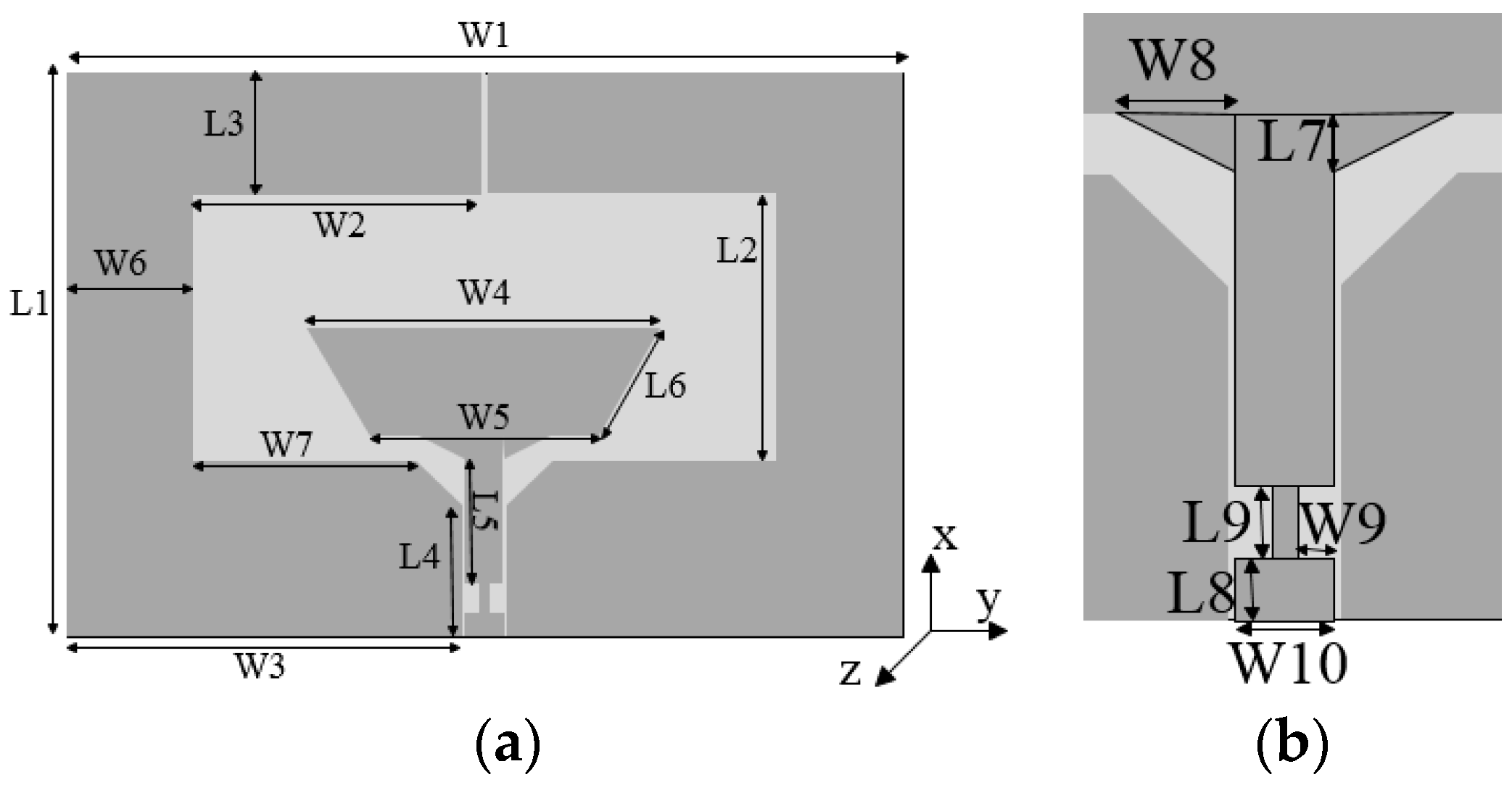
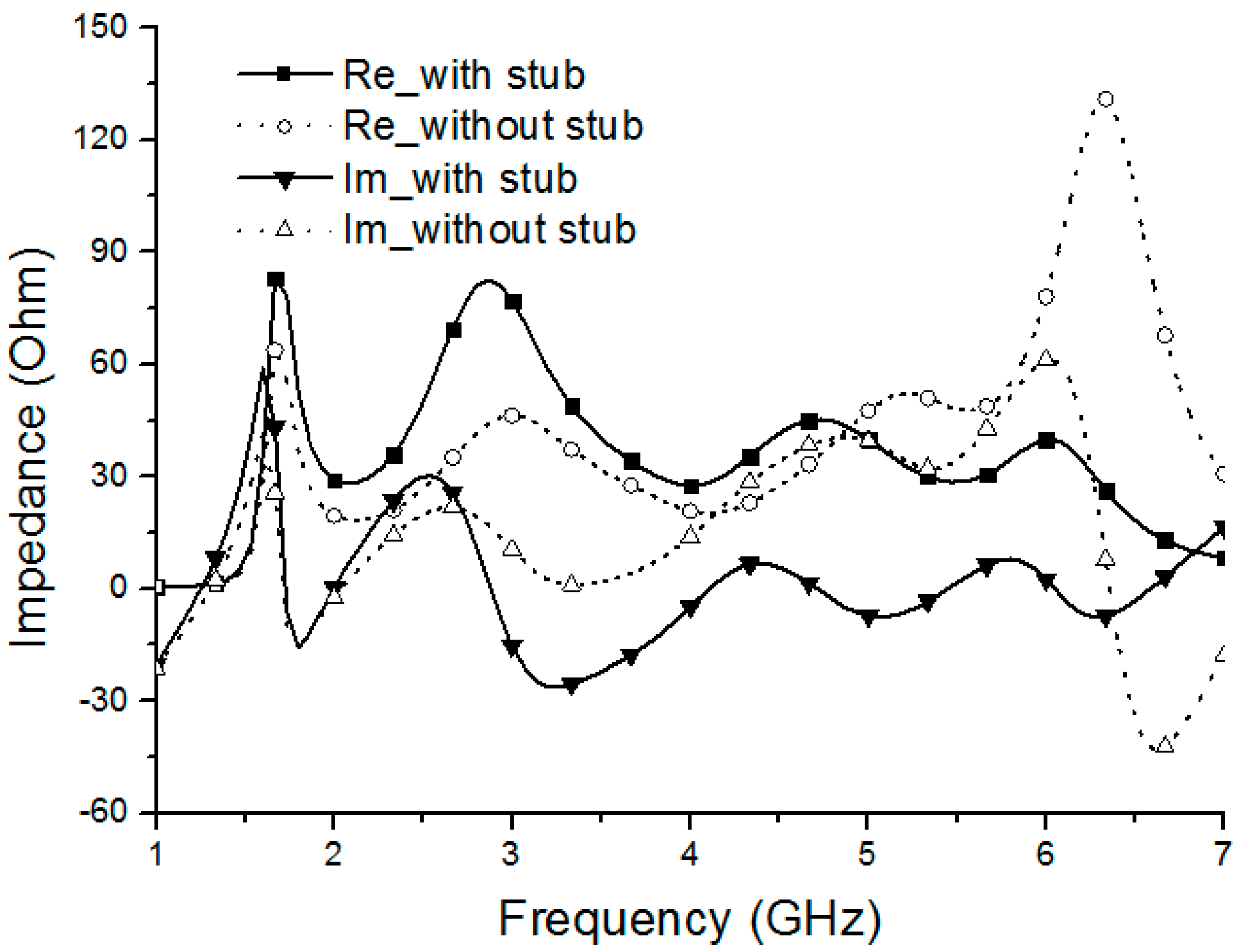


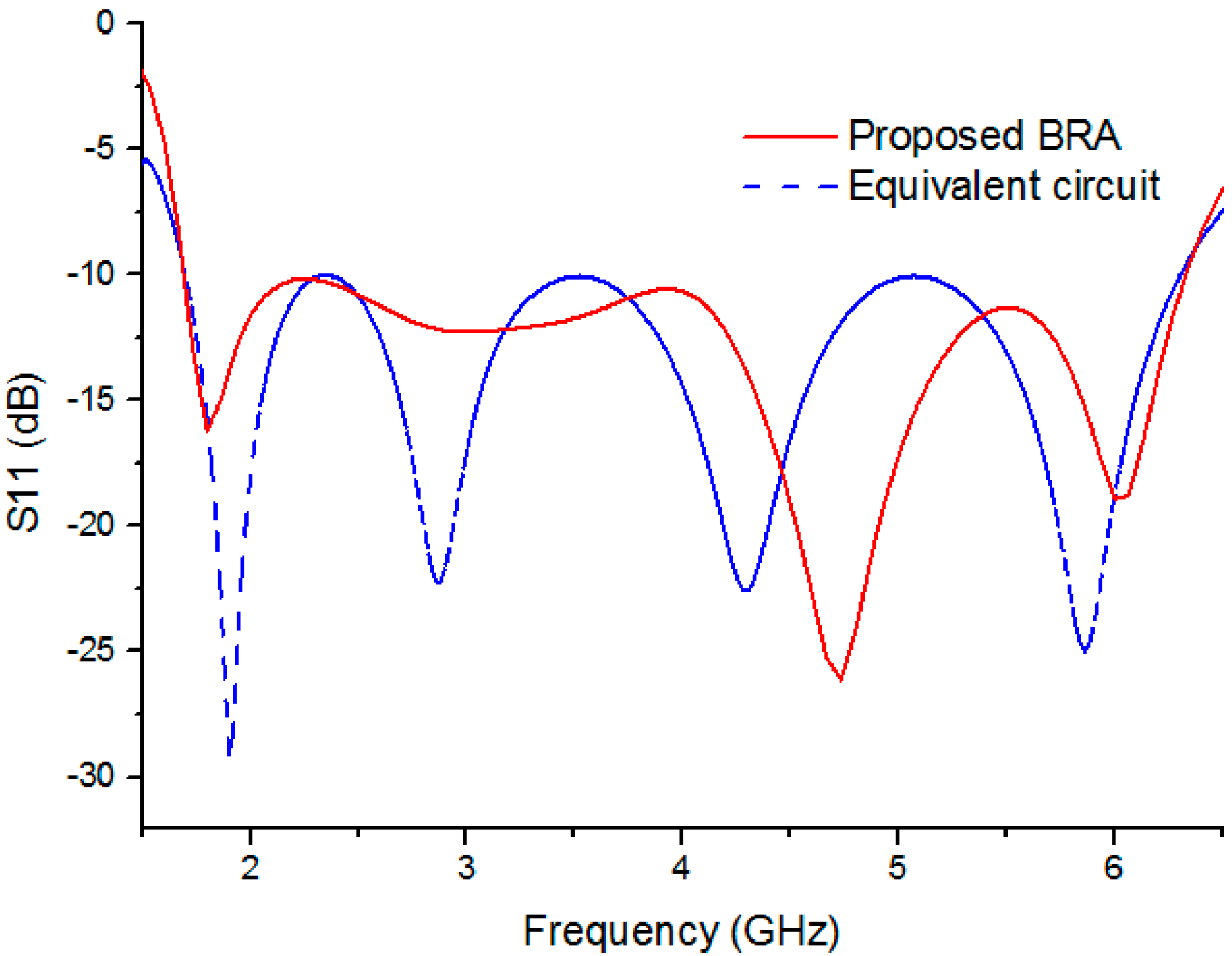



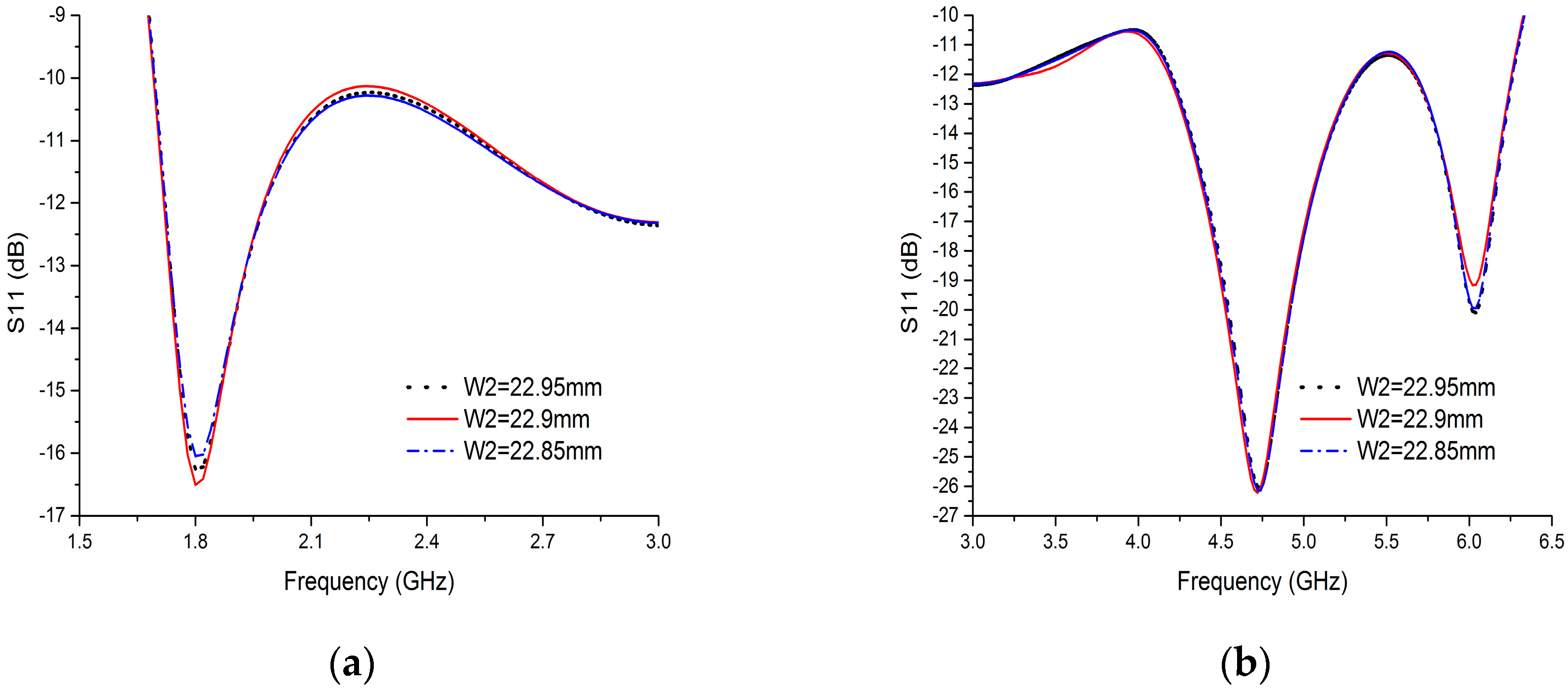
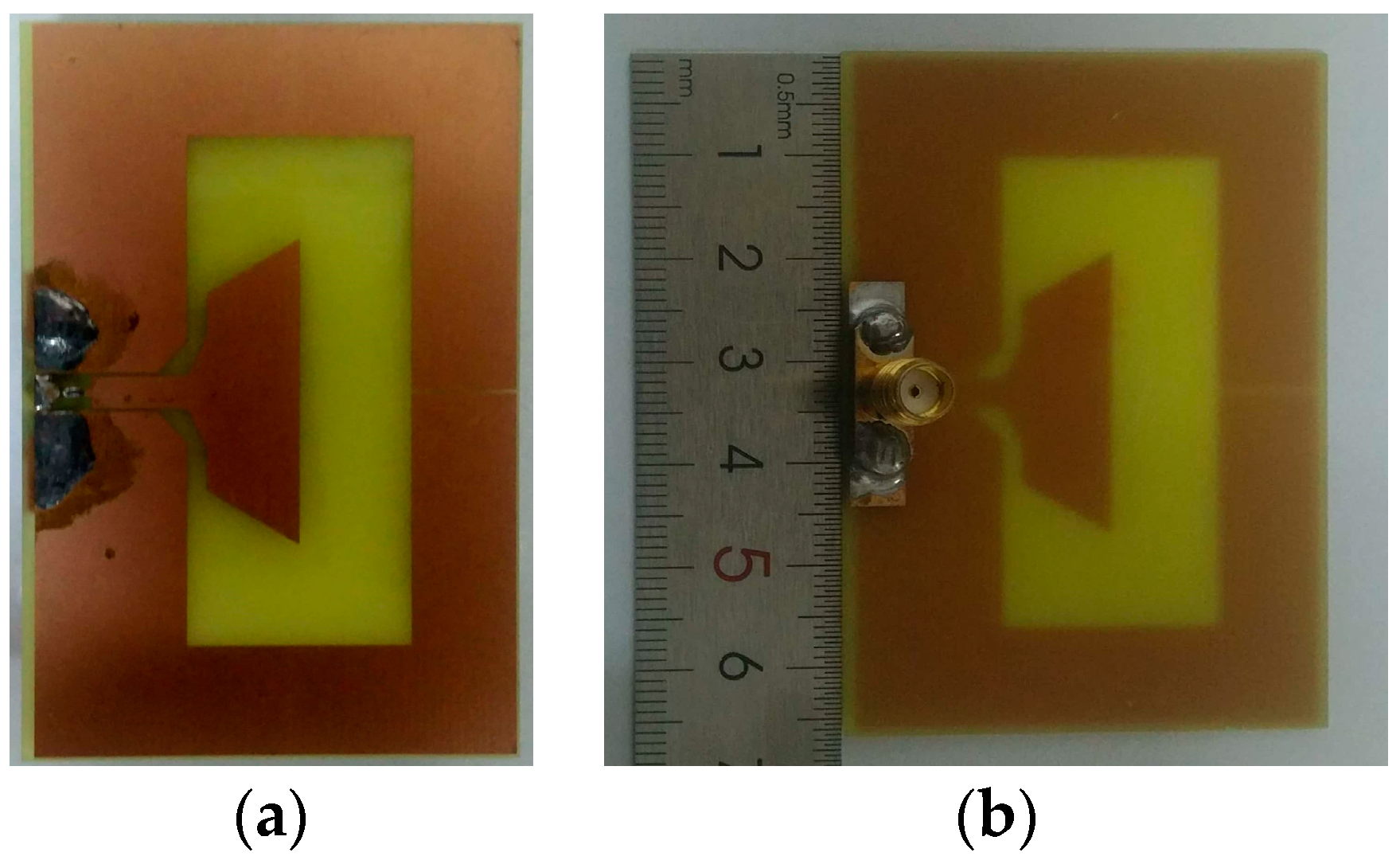
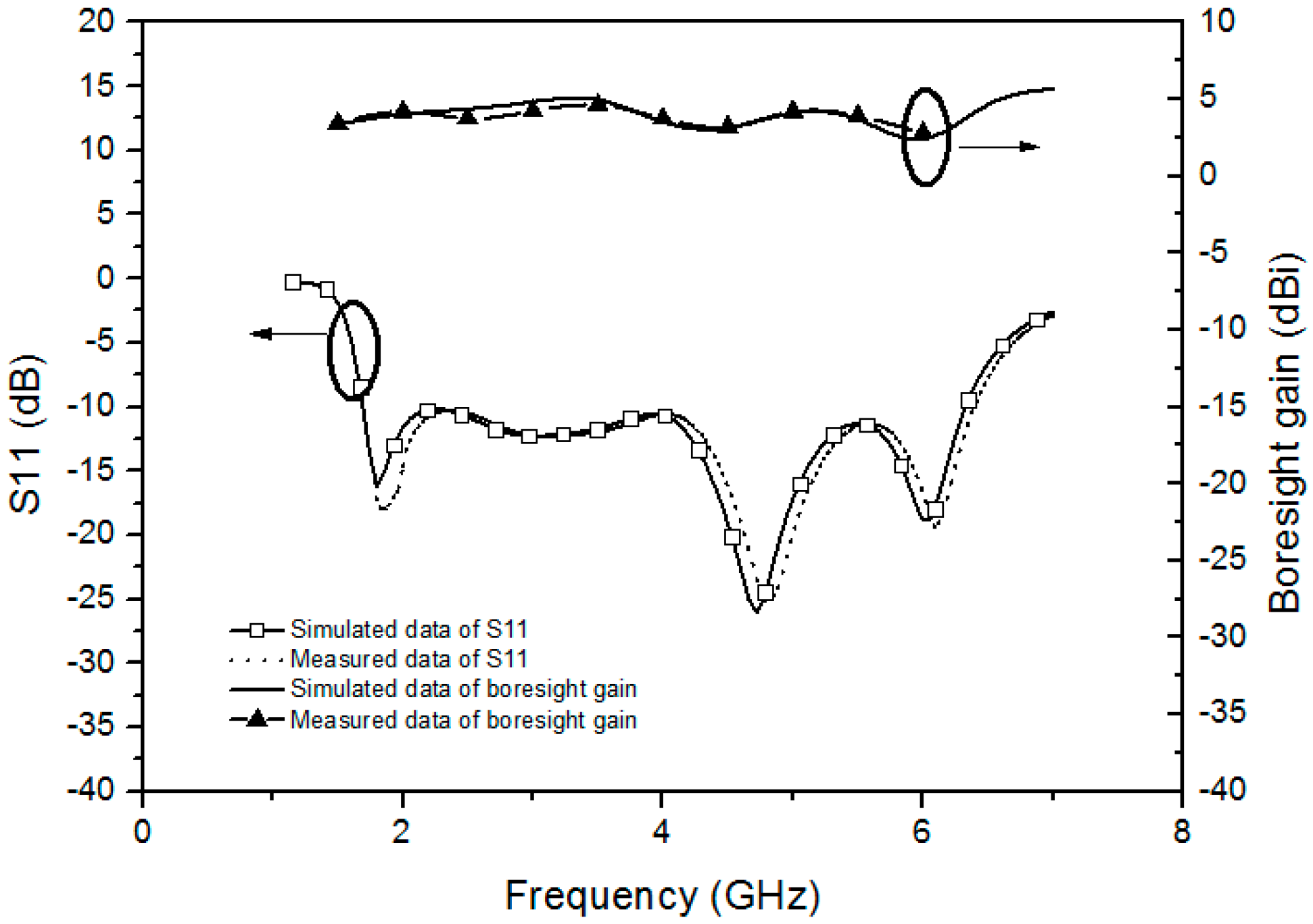
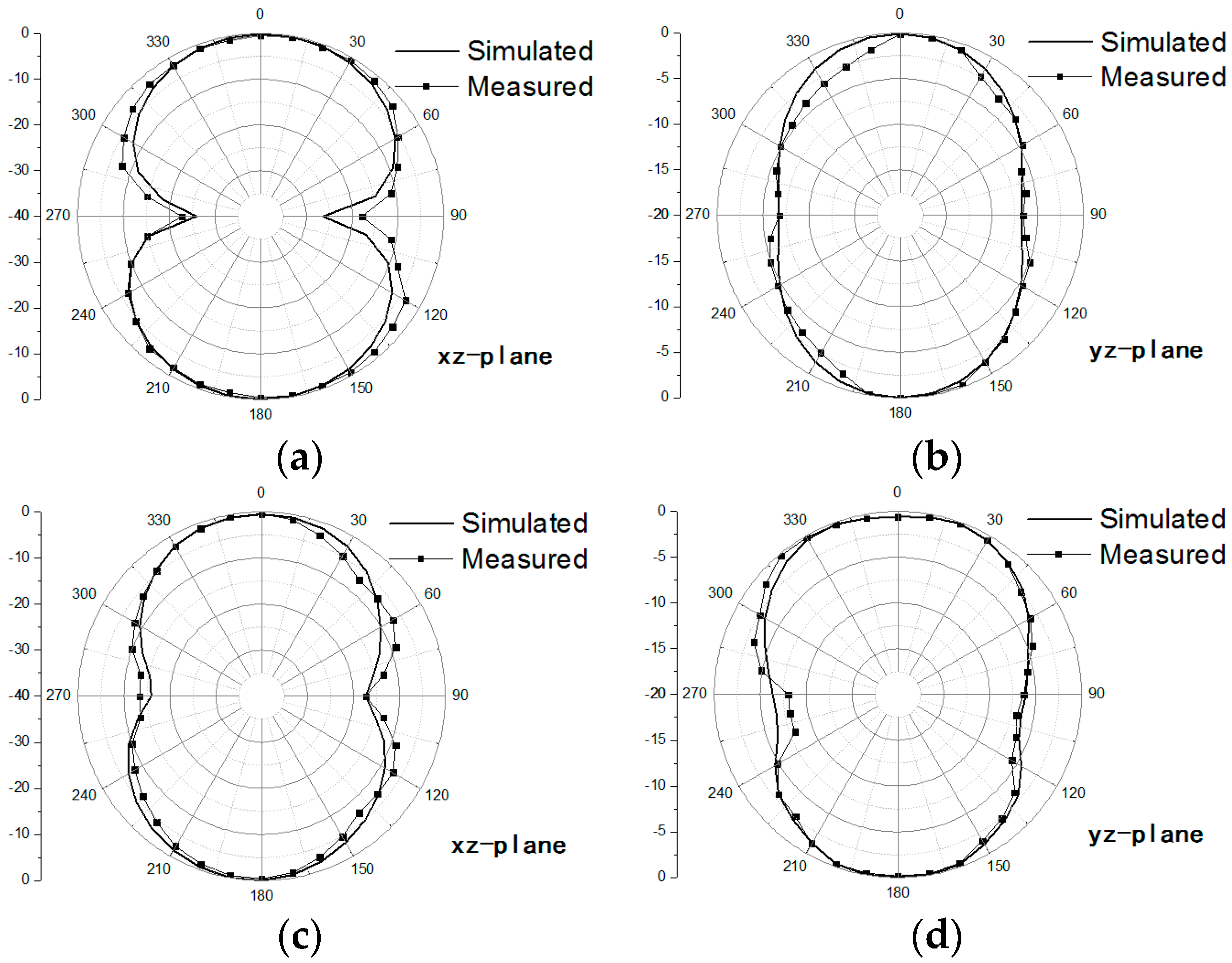
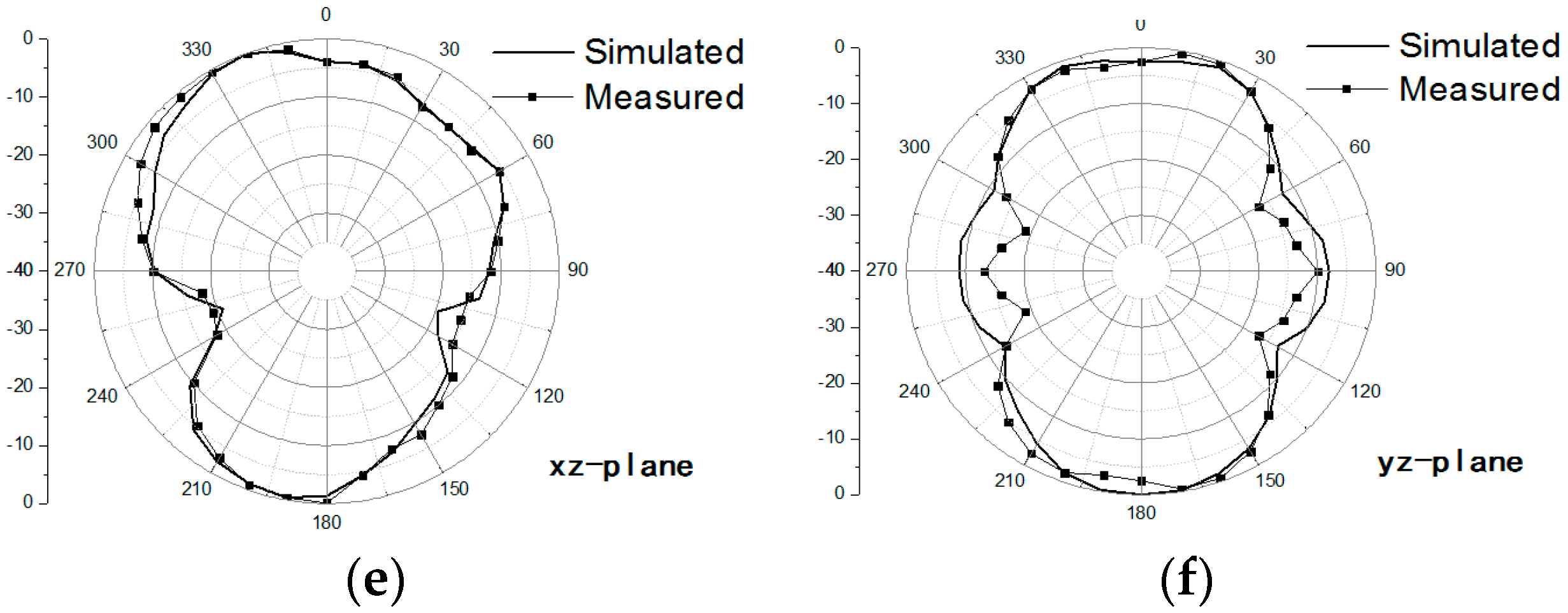
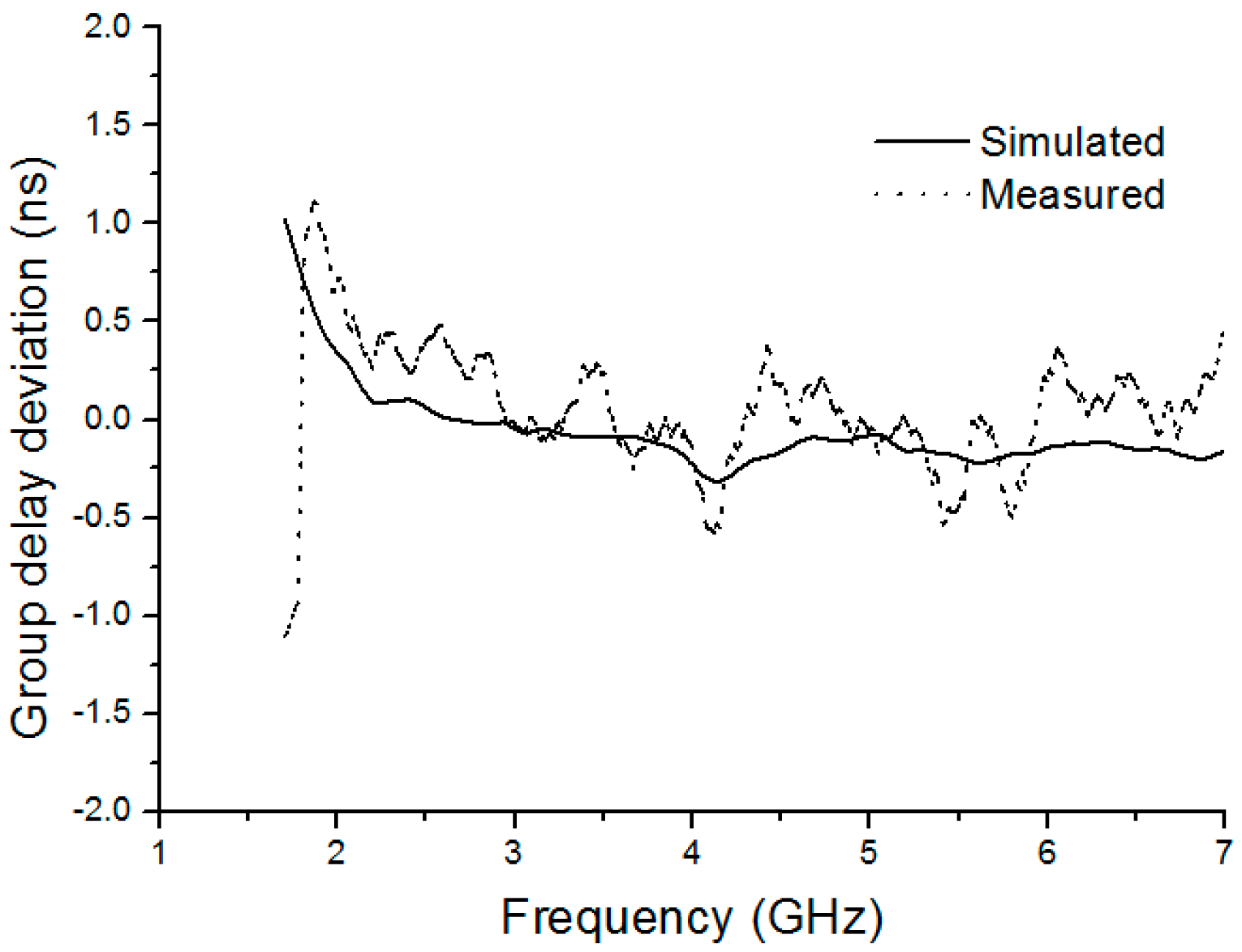
| Parameters | Value (mm) | Parameters | Value (mm) |
|---|---|---|---|
| L1 | 44.4 | L2 | 20.7 |
| L3 | 9.7 | L4 | 11.2 |
| L5 | 10.6 | L6 | 9.92 |
| L7 | 1.8 | L8 | 1.6 |
| L9 | 3.6 | W1 | 66 |
| W2 | 22.9 | W3 | 31.28 |
| W4 | 27.92 | W5 | 18 |
| W6 | 10 | W7 | 28.48 |
| W8 | 3.7 | W9 | 1.1 |
| W10 | 3 |
| Parameters | Value | Parameters | Value |
|---|---|---|---|
| LDC1 | 0.39 nH | LDC2 | 1.13 nH |
| LDC3 | 0.87 nH | LDC4 | 0.74 nH |
| LDC5 | 0.68 nH | CDC1 | 1.14 pF |
| CDC2 | 2.36 pF | CDC3 | 3.94 pF |
| CDC4 | 9.97 pF | CDC5 | 11.82 pF |
| RDC1 | 2.43 Ω | RDC2 | 2.51 Ω |
| RDC3 | 2.03 Ω | RDC4 | 2.18 Ω |
| RDC5 | 1.9 Ω |
| Literature | Dimensions (λ3) | Bandwidth (GHz) | Gain (dBi) | Radiation Pattern | Applications |
|---|---|---|---|---|---|
| [4] | 0.22 × 0.25 × 0.013 | 2.38–11.8 (132%) | 2.3–5.6 | bidirectional | WLAN/LTE/UWB |
| [23] | 0.85 × 0.65 × 0.048 | 3.18–11 (110%) | 1.1–7.2 | directional | WBAN |
| [24] | 0.54 × 0.65 × 0.0085 | 3.2–10.9 (109%) | 1.2–5.1 | bidirectional | GSM/PCS/WLAN |
| [25] | 0.68 × 0.75 × 0.0044 | 2.6–11 (123%) | 1.3–5.3 | bidirectional | WIMAX/UWB |
| [26] | 0.21 × 0.21 × 0.0082 | 3.04–10.87 (112%) | 2–4.5 | bidirectional | UWB |
| [27] | 0.24 × 0.27 × 0.014 | 2.7–12.4 (128%) | −1–4 | bidirectional | UWB |
| [28] | 0.41 × 0.39 × 0.016 | 3.1–10.6 (109%) | 2–7 | bidirectional | UWB |
| [29] | 0.44 × 0.44 × 0.0037 | 2.2–30 (172%) | - 1 | bidirectional | UWB |
| [30] | 0.27 × 0.27 × 0.017 | 3.1–11.1 (112%) | −1–5.5 | bidirectional | UWB |
| proposed | 0.25 × 0.3 × 0.0063 | 1.7–6.3 (115%) | 2.35–4.85 | bidirectional | 3G/4G/5G/WIFI/Bluetooth |
Publisher’s Note: MDPI stays neutral with regard to jurisdictional claims in published maps and institutional affiliations. |
© 2020 by the authors. Licensee MDPI, Basel, Switzerland. This article is an open access article distributed under the terms and conditions of the Creative Commons Attribution (CC BY) license (http://creativecommons.org/licenses/by/4.0/).
Share and Cite
Zhang, C.; Xie, Y.; Dai, L. UWB Low-Profile Boat-Radiator Antenna (BRA) with Dual C-Shape Co-Radiative Ground for Multi-Standard Communication Networks. Sensors 2020, 20, 7051. https://doi.org/10.3390/s20247051
Zhang C, Xie Y, Dai L. UWB Low-Profile Boat-Radiator Antenna (BRA) with Dual C-Shape Co-Radiative Ground for Multi-Standard Communication Networks. Sensors. 2020; 20(24):7051. https://doi.org/10.3390/s20247051
Chicago/Turabian StyleZhang, Chungang, Yongjun Xie, and Legen Dai. 2020. "UWB Low-Profile Boat-Radiator Antenna (BRA) with Dual C-Shape Co-Radiative Ground for Multi-Standard Communication Networks" Sensors 20, no. 24: 7051. https://doi.org/10.3390/s20247051






